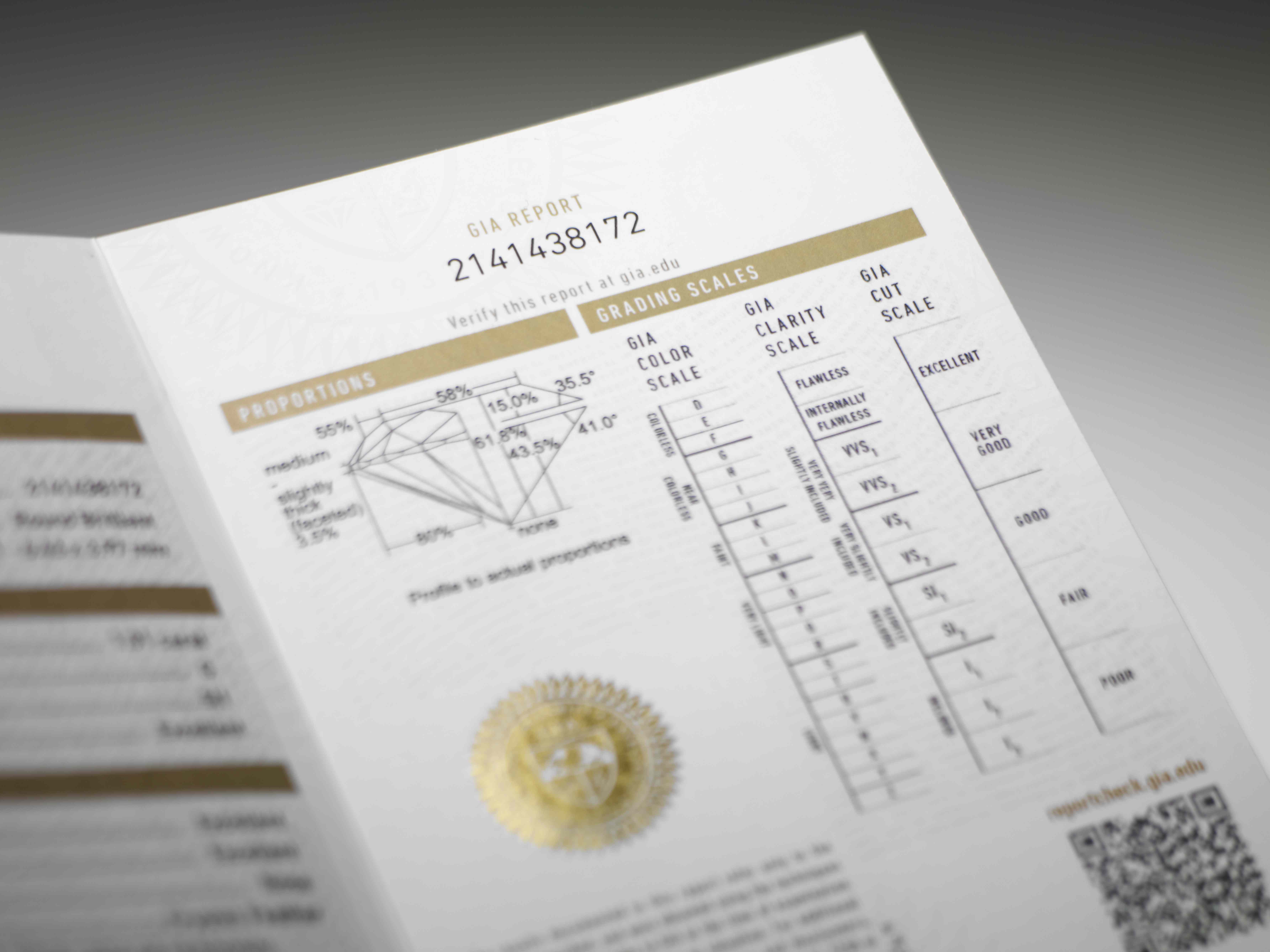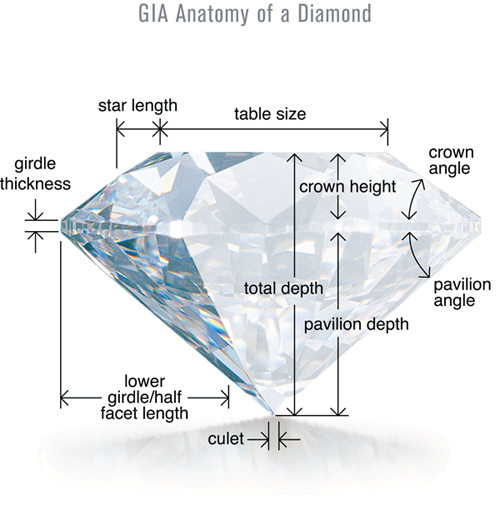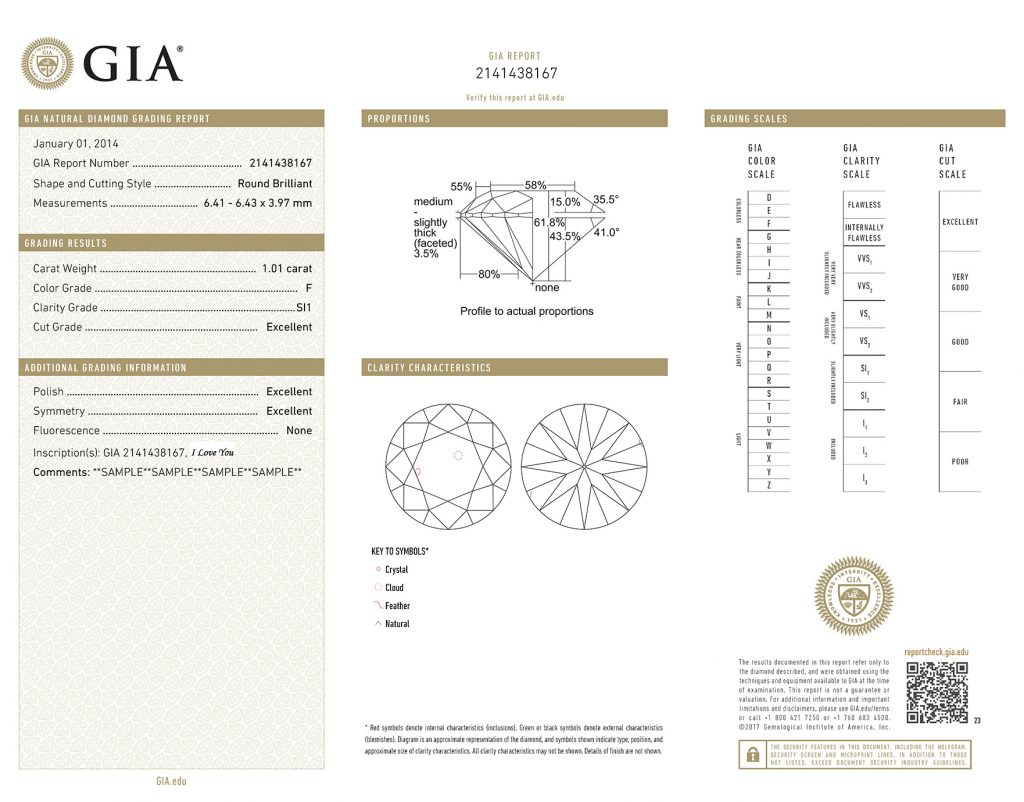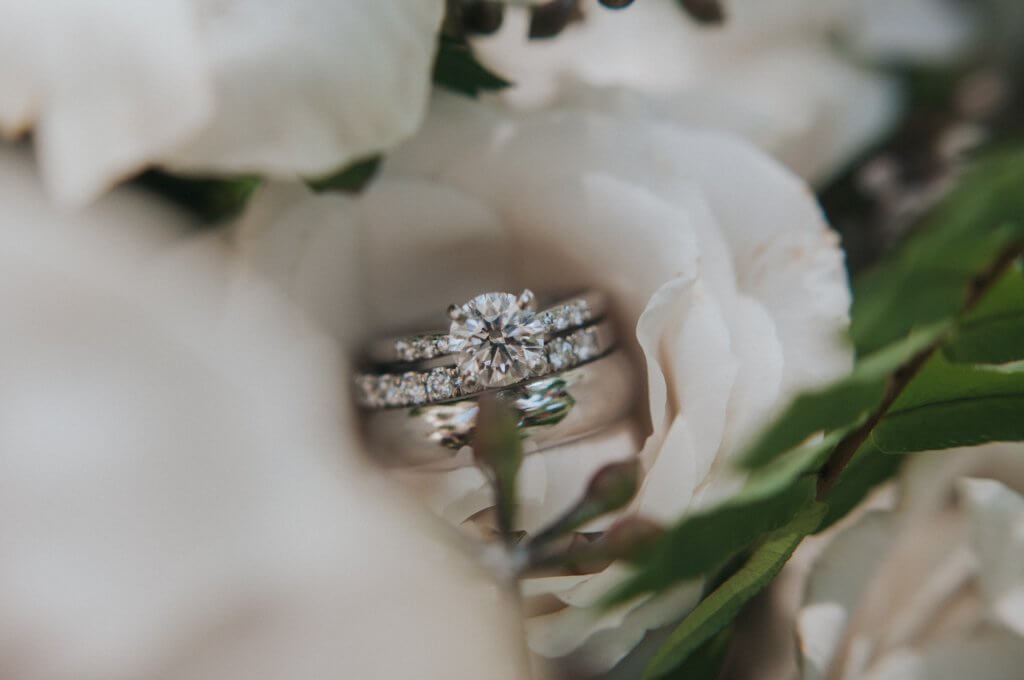Check a GIA Report and Certificates
GIA Diamond Certification Check & Lookup: Protecting Yourself from Fraud
Key Takeaways
- The Gemological Institute of America is by far the most reputable diamond lab there is. With decades behind them, and an unbiased position in the diamond world, their reports offer the greatest benefit to shoppers.
- The GIA grades diamonds using the Four Cs – Cut, Clarity, Color and Carat – along with other features like fluorescence, proportion, and culet and girdle size.
- Their reports are very easy to interpret, even if you’re new to the diamond world. The GIA’s reports are specifically designed to offer clarity to first-time shoppers, and to level the playing field for everyone involved.
- Any GIA report can be verified using the unique report number, and our own database search.

If you’ve spent any amount of time on our site, then you’ve no doubt come across the name ‘GIA’ more than once already. Even if you’re still unsure what, exactly, it refers to, you’ve probably been able to surmise that it’s pretty central to the process of buying a beautiful diamond.
Put simply, the GIA – or, in full, the Gemological Institute of America – is a non-profit organization dedicated to maintaining an incredibly high standard for grading diamonds before they are made available to prospective buyers.
They are also the forerunners of the Four Cs – cut, color, clarity and carat – which represent the most significant aspects for any diamond’s beauty and value, although many other bodies have put their own interpretation on ‘The Four Cs’ over the years.
GIA diamond is a term you will come across when shopping for an engagement ring, and it certainly pays to understand how you can use it as a guide during your search. Learn about GIA diamonds and why savvy shoppers trust GIA.
- The Basics
- The History of GIA Diamond Grading
- The GIA Grading Scales
- The GIA Diamond Report
- Sample GIA Diamond Report
- FAQs
- Our Summary
The Basics
Everything you need to know about the GIA’s history, purpose, and regard within the global diamond community, in one place.
What is a GIA Diamond?
As mentioned above, a GIA diamond one that has been formally graded by the GIA.
The GIA represents an independent and unbiased organization that conducts gemstone research, trains gemstone professionals, and sets the standards for determining diamonds’ quality. One of the main functions of GIA is the sorting of diamonds. You may have heard about the diamond grade 4Cs: color, clarity, cut, and carat weight. The GIA developed this standard, along with detailed methodologies for evaluating each “C”, and the classification terminology used to describe them.
GIA doesn’t mine diamonds, nor does it buy, sell, or trade them. It does not value diamonds and is not otherwise involved in the pricing or valuation of diamonds. GIA operates independently of these commercial interests and ensures that diamond quality assessments are entirely objective and unbiased.
Why does this matter? Because a number of other organizations offering diamond grading do so for profit, and tend to prioritize grading larger quantities of diamonds in much smaller timeframes. Their results are less consistent, and tend to grade diamonds much higher than the GIA. As a result, they are favored by chain jewelry stores, who deal with much higher numbers – and margins.
If you want to know the quality of the diamond you are considering, and because quality and price go hand in hand, you should look for GIA graded diamonds, and learn how to understand the corresponding GIA reports assessing diamonds.
What does it mean for a diamond to be a “GIA Certified Diamond”?
“GIA certified diamond” is a misnomer. GIA does not certify diamonds – it assesses them. The terms “GIA Certified” and “GIA Certificate” are commonly used in the jewelry industry to refer to diamonds that have undergone GIA’s rigorous assessment process, and are now accompanied by an official report created by the GIA’s expert graders.
GIA itself does not use the word “certificate” to describe the document it issues. The GIA examines the diamond, describes its characteristics, and assesses it according to the 4Cs. It does not certify the diamond or its value. On the contrary, like other science labs, GIA issues a report on the results of the evaluation of a particular diamond and believes that “report” is the correct term to describe the classification results.
A GIA diamond grading report is essential when buying a diamond. GIA offers reports in several formats, including digital versions, each containing the trusted and highly accurate classification information that diamond shoppers can rely on.
Is Every Diamond a GIA Diamond?
No, GIA does not grade all diamonds that make their way onto the market. However, it may seem like it, given the sheer number of GIA-graded diamonds on the market.
Some vendors favor other organizations’ approaches, whether due to economy or speed – or, of course, the fact that other organizations are not quite as stringent, and will award higher, more valuable grades to lower quality diamonds – but the GIA is still widely regarded as the most reliable, and the method that most benefits the buyer, as well as the vendor.
To ensure the GIA has assessed your diamond, you can request the GIA assessment report. In addition to a full assessment of the diamond’s 4Cs, the GIA report includes a unique number, which is sometimes also engraved on the diamond’s girdle. You can use the report number to access GIA’s online global report database, GIA Report Check, check if the diamond has a GIA grading, and view all grading details.
How Does GIA Ensure Objectivity in Diamond Sorting?
The GIA has robust procedures to ensure the anonymity of a diamond and the objectivity of the grading process. This is one of the reasons why the GIA is regarded as the most reliable lab, as it does not show any bias toward vendors.
Upon arrival at the lab, the gemologists keep the diamond in an anonymous transparent storage box without any reference to its owner. Throughout the process, it is tracked using a barcode label. All of these precautions ensure that a GIA assessment report objectively reflects the characteristics of a diamond.
GIA diamond graders accurately assess the color, clarity, cut, and carat weight of the diamond. More experienced personnel gemologists can review some or all of the information, and provide independent opinions. The official grades are only given once all graders have reached a consensus.
The History of GIA Diamond Grading
The Gemological Institute of America was founded in 1930s Los Angeles, by a jeweler named Robert M. Shipley. As a jeweler, Shipley had become dissatisfied with the way precious gemstones were dealt with by the industry and, after filling the gaps in his own knowledge, he sought to ensure a high standard of education for other jewelers and gemologists.
The GIA follows a strong code of ethics that ensures an unbiased approach to every single diamond they are asked to grade. They are also committed to furthering research and development, improving the methods and techniques its graders use to ensure the most objective approach to aspects like color and clarity – which, historically, have proven the most subjective – and, ultimately, ensuring a fair and honest approach to the valuation of diamonds.
The GIA now runs multiple campuses across the world, and opportunities for remote learning, as it continues to break new ground in the diamond industry, and maintain a high level of clarity for newcomers and experts alike.
The GIA Grading Scales
The GIA was the first to devise the use of the ‘Four Cs’ as a means of breaking down a diamond’s quality into its most significant parts: Cut, Color, Clarity and Carat (weight).

Cut
Diamond cut is, inarguably, the most important of the First Cs to get right since it has by far the strongest bearing on your diamond’s brilliance.
The GIA grades Round Brilliant diamonds according to the following cut scale: Excellent, Very Good, Good, Fair and Poor. In order to create as much consistency and predictability as possible in what is, at heart, a subjective subject, the GIA’s researchers have augmented their research by looking at more than 70,000 diamonds over the period of around 15 years.
The GIA also provides separate grades for Symmetry and Polish, which are given for Round Brilliant diamonds and all other shapes, too. They follow the same scale as the Cut grade, with each subcategory influencing a diamond’s sparkle and value.
It is important to note that a Round Brilliant diamond needn’t be given an Excellent for polish in order to be given an Excellent for Cut. If it scores Excellent in all three areas, however, it is known as a 3X Diamond.
Color
In clear diamonds, color refers to the extent to which the diamond is impacted by trace amounts of nitrogen, which produces a yellow tint within the stones that varies from very vague (and only visible under magnification) to very obvious. Understandably, buyers want to avoid any visible yellow tint in their diamond.
Again, this represents another category where some discrepancy in opinion is expected, but the GIA’s researchers have ensured the greatest degree of consistency possible is adhered to by its graders.
The scale runs alphabetically from D to Z, and is divided into the following subcategories
| Colorless | Near Colorless | Faint | Very Light | Light |
| D, E, F | G, H, I, J | K, L, M | N, O P, Q, R | S, T, U, V, W, X, Y, Z |

For any GIA graded diamond, you can be sure that at least two graders have analyzed color independently. An official grade is not recorded until these graders reach an agreement, and the diamond may be examined by additional graders in order for that agreement to be reached.
Clarity
A diamond’s most distinguishing features are its inclusions – small, oftentimes microscopic, flaws that occur in the internal structure of the stone while it is still underground that, like birthmarks, make it unique.
But, while these distinguishing features possess their own charm, diamond buyers understandably want to avoid any diamonds bearing inclusions significant enough to infringe on the diamond’s beauty. This is why total transparency around the diamond’s clarity is so important.
Clarity is documented using the following grades:
- FL and IF (Flawless and Internally Flawless)
- VVS1 and VVS2 (Very, Very Slight Inclusions 1 & 2)
- VS1 and VS2 (Very Slight Inclusions 1 & 2)
- SI1 and SI2 (Slight Inclusions 1 & 2)
- I1 and I2 (Inclusions 1 & 2)

Understandably, each clarity grade has a significant impact on the value of the diamond – although some have a greater impact than others, with flawless diamonds (both FL and IF) costing thousands of dollars more than diamonds that are otherwise comparable.
As with color, at least two graders will independently inspect the diamond’s clarity under 10x magnification. Any inclusions, whether microscopic or significant enough to be seen by the naked eye, will be mapped on a diagram within the GIA report.
Carat
Carat refers to the diamond’s weight, rather than its size, with one carat equal to 0.2 grams (or, of course, 200 milligrams). So, a 2.5 carat diamond is the equivalent of 0.5 grams, or 500 milligrams.
A diamond’s weight has a major bearing on its value, with larger diamonds – even those of a lower quality – earning a very high market value. This is particularly true for diamonds that meet the ‘magic weights’ that so many shoppers focus on, such as 1, 1.5, 2, 2.5 and so on. At these weights, even a difference of 0.1 (or less) could mean hundreds of dollars for the vendor.
As a result, any diamond needs to be weighed to an incredibly high degree of accuracy – or its value could be set far too high, or far too low.
GIA graders use an electronic microbalance, which provides an accurate weight to the fifth decimal place.
The GIA Diamond Report
While using the Four Cs is a great way of condensing the most significant features of any diamond into an easily accessible document, there is a little more to finding a great diamond than that – and, within any GIA diamond report, you’ll find a few additional details to help you make your decision.
Alongside the grades for Cut, Color and Clarity, you will find:
- A unique report number, which can be used to verify the authenticity of the report against the GIA’s database.
- A grade for fluorescence.
- Detailed information on the diamond’s proportions: table and depth percentages – vital to picking out a beautiful diamond – as well as length to width ratio.
- Laser inscription

The GIA does not offer information on Hearts and Arrows diamonds, nor does it consider ‘Triple X’ diamonds to be an official designation, so you will not find any mention of either of these two features in your GIA report.
Sample GIA Diamond Report

FAQ
All those extra questions you have about GIA diamonds, answered in one place.
Do I Need to Have a Diamond Assessed?
It is essential that the diamond you pick has been formally graded, preferably by the GIA. But, provided it is accompanied by a valid GIA report, you don’t need to go out of your way to get it assessed again.
A diamond engagement ring is one of the most important purchases you make. It can also be one of the most expensive. Therefore, you want to be sure that you are getting a reasonable price for the diamond you consider.
A GIA diamond grading report gives you all the essential information you need to know about a diamond’s 4Cs, as well as its fluorescence, any treatments, and more. With a GIA diamond grading report, you can be sure that your diamond is natural. That’s because GIA has researched and tested the diamond using the most advanced tools and procedures available, based on the Institute’s ongoing scientific research.
Since a GIA diamond grading report is an unbiased assessment of a stone’s quality characteristics, you can compare one GIA-graded diamond to another. This allows you to compare the quality of loose diamonds and decide which one is the best value and suitable for you.
Ensuring the diamond you are viewing comes with a GIA diamond grading report is like getting an independent inspection before buying a car or home. It’s a smart step in your buying process – and many insurance companies require a GIA assessment report as the basis for ensuring your diamond.
GIA grades all shapes of diamonds, and the square princess shape is one of the most popular diamonds for engagement rings.
How do You Get a Diamond “GIA Certified”?
The GIA does not certify diamonds, it grades them, and anyone can submit a diamond to GIA for assessment. You can drop off a stone at one of GIA’s nine labs, located in gem and jewelry capitals worldwide, or you can ship it to GIA.
Given the complexity of packaging, shipping, and insuring diamonds, and because GIA only assesses unmounted gemstones, your best option is to partner with your local jeweler to supply the stone on your behalf.
Many diamonds in stores and online already have a GIA grading report, which you can request before purchasing – and compare against our GIA Diamond Report Look Up, which contains the details of over 2 million GIA graded diamonds. Once you complete your purchase, you’ll receive your diamond report.
Are “GIA Certified” Diamonds More Expensive?
No, the GIA’s fee for grading diamonds is very inexpensive compared with the cost of the diamond itself, diamonds graded by the GIA are not more expensive than diamonds graded by other bodies.
Again, “GIA Certified” really is a misnomer for GIA diamonds. There is a false idea that GIA diamonds cost more, often based on comparing diamonds based on the price tag without considering their quality.
After all, the price of a diamond, car or other valuable item is linked to quality. If you’re not sure what quality you’re getting, how do you know if you’re overpaying or getting a good deal? Therefore, it is essential to compare prices for diamonds with the same 4C quality characteristics and whose qualities have been accurately and objectively assessed by the same independent laboratory as GIA.
Having a diamond assessed by GIA is not expensive. GIA charges only $ 48 for a grading report for a 0.70 ct to 0.99 ct diamond, and only $ 80 for a 1.00 ct to 1.49 ct diamond (and, besides, most jewelers include the grading fee in the price of the diamond). Since couples spent an average of $ 6,351 on an engagement ring in 2017, a GIA diamond grading report’s cost is a small price for peace of mind.
Where Can I Find a GIA Diamond?
Most quality jewelers offer diamonds with GIA grading reports. The GIA Retailer Lookup can help you find retailers near you selling GIA diamonds or having GIA-trained staff. Popular e-commerce websites also sell GIA diamonds., although we would only ever recommend you purchasing a diamond that you have seen for yourself in person, first.
You can also take a look at our massive variety of GIA graded diamonds, then go to view them in-person with one of WillYou.Net’s approved local jewelers.
Can a GIA Certificate be Fake?
While it is possible to put together a convincing forgery, it is impossible for anyone to fake a GIA report number, so comparing this unique number against a reliable database will ensure you aren’t duped.
While GIA diamonds are not worth more than other diamonds, their reports are considered to be the most reliable and consistent – making them far more attractive investments than diamonds graded by institutions with vested interests, or profits to make.
This is why, on occasion, someone will attempt to fake a GIA report on a diamond that would otherwise be given lower grades, and a lower value. However, as we mentioned above, the GIA’s report numbering system is foolproof, and you needn’t worry so long as you shop from reputable vendors.
Is GIA a Non-Profit?
Yes, the GIA is a non-profit institute dedicated to ensuring a level playing field for anyone looking to buy or sell a diamond.
The GIA was established as a result of a significant lack of transparency in the worlds of precious gemstones and fine jewelry, in order to bring education, clarity and fairness to newcomers and experts alike.
Even now, more than ninety years on, the Gemological Institute of America continues to uphold those values, rather than making a fast profit by offering a rapid turnaround on diamond reports that often favors the vendor, rather than the buyer.
While it might not seem like a big issue, this is a major factor to consider if you’re still on the fence between GIA graded diamonds, and one from another lab that looks like a good deal.
How Much Does It Cost To Get A Diamond GIA Certified?
Diamonds that are purchased from a local jeweler or online typically include the GIA grading report along with the overall cost of the diamond. But acquiring a GIA certification for a diamond itself isn’t too expensive. The report for a diamond weighing 0.70ct – 0.99ct costs around $48, and a diamond weighing the standard weight of 1 carat costs $110. It’s a small price to pay for insurance of a diamond.
What are the benefits of a GIA Certification?
The GIA is a highly respected certification and having a diamond certified through GIA has many benefits. First, the certification offers a reliable grading for the diamond. It also ensures that your diamond has been analyzed by the best in the diamond business, and that you’re receiving the diamond quality that is stated on the certificate. It provides a peace of mind about your diamond’s authenticity and the high-security measures taken to grade the diamond.
Where can get a diamond GIA certified in the US?
There are two GIA labs in the United States, located in New York City and Carlsbad.
In order to get a diamond certified (or graded), anyone can submit a diamond to a GIA lab, worldwide. Having a diamond graded by GIA is a simple process that involves shipping the diamond to one of their labs. However, because of the issues involved in shipping, insuring and packaging diamonds, it is highly recommended to have a local jeweler submit the diamond on your behalf.
Our Summary: Should You Buy a GIA Diamond?
In our opinion, yes, when it comes to making the best possible investment, a GIA report is the strongest guarantee any buyer could hope for.
We’re not saying that you won’t find high quality, beautiful diamonds that have been graded by a different institution, but that the GIA’s efforts to accurately grade each feature are the most painstaking – meaning that you won’t have to worry about overpaying for features or a level of quality that isn’t there.
Buying a diamond is a complex process – one that hinges on transparency, understanding, and the ability to really understand the diamond you’re interested in, even if you’re a total newcomer to the diamond world. This is what the GIA was designed to support, and the most compelling reason for any buyer to focus their search on GIA graded diamonds.
Common Questions








